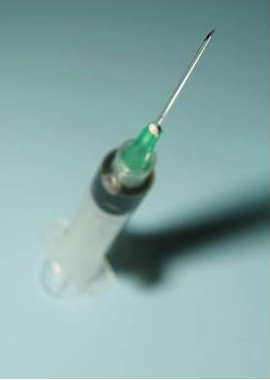The Influenza Vaccine Controversy
Are Vaccines Safe During Pregnancy?
Data from the 2009/2010 flu season are revealing more fuel for the vaccine controversy fire.
Pregnant women who received both the seasonal flu vaccine and the H1N1 vaccine during the 2009/2010 flu season were more than 40-times more likely to lose their baby following vaccination.
What the Science Shows:
2009/2010 saw a four-fold increase in pregnant women being vaccinated, presumably due to public service announcements about the H1N1 threat. In previous years, 11.3% of the pregnant population, on average, elected to receive the seasonal flu vaccine. In 2009/2010, 43% of pregnant women were vaccinated.
|
Once corrected for underreporting, researchers estimate that 1 in 1695 pregnant women who received the dual seasonal flu and H1N1 vaccines suffered a spontaneous abortion or stillbirth. This represents a 43.5-fold increase in fetal death compared to the previous and subsequent flu vaccine seasons. |
 |
The authors conclude that the “increase in fetal-loss reports associated with the administration of the 2009 A-H1N1 vaccine appears to be attributable to some type of toxicity effect…”
It is unknown what portion of the H1N1 vaccine, or synergy between the two vaccines accounts for increased fetal demise. Previous studies in pregnant rabbits showed that mercury accumulates in the fetal brain, liver and kidneys within hours of thimerosal injection. Thimerosal is a mercury product used as a preservative in many vaccines. Two doses of thimerosal from vaccines equals 50 mcg of mercury directly injected, which is well above the EPA-established allowable dosage of 0.1mcg of mercury per kg of body weight per day. This does not even take into account that mercury has been found to preferentially bioaccumulate in fetal tissue.
The CDC did recommend the H1N1 vaccine for pregnant women based on the safety record of seasonal flu vaccines. However, the insert for the H1N1 vaccine states: “It is also not known whether these vaccines can cause fetal harm when administered to pregnant women or can affect reproduction capacity.”
What Researchers Did:
Researchers studied the Vaccine Adverse Event Reporting System (VAERS) to determine whether the 2009/2010 influenza season - which featured both the seasonal flu vaccine and the H1N1 vaccine - resulted in increased fetal deaths among vaccinated pregnant women.
VAERS is subject to dramatic underreporting. Some conditions are not commonly perceived as a potential side-effect of a recent vaccination, and some physicians fail to report conditions even when there is knowledge of a possible association with a vaccine. In order to compensate for this underreporting, the researchers cross-examined another database established by the National Coalition of Organized Women (NCOW), which also maintained a reporting system for women who had received the influenza vaccines while pregnant.
Researchers also compared the 2009/2010 vaccine season with the prior flu season and the subsequent season – ultimately reviewing statistics between 2008 and 2011.
The authors point out that low fetal-loss reports from previous seasons are not an indication of vaccine safety, but rather, evidence of very low rates of reporting . The theory is that physicians and patients are not likely to report fetal loss as a complication of vaccines because it is not widely known as a potential side-effect.
The Bottom-Line:
The authors draw the conclusion that “the concomitant administration of the seasonal influenza and pandemic A-H1N1 vaccines during 2009/2010 suggests a synergistic toxicity and a statistically significant higher rate of fetal loss reporting relative to the single-dose seasons.” So high, that approximately 1 in every 1695 pregnant women who received both flu vaccines that season lost their babies to a miscarriage or stillbirth.
A sufficient number to re-think the vaccine controversy, perhaps?
In addition, the authors caution that statistics have not been performed on surviving children whose mothers received a double vaccination in 2009/2010. It is unlikely that those adverse events would be reported in VAERS since it could take months or years for them to manifest themselves.
Ultimately, this research calls for further investigation into the synergistic effects of multiple vaccine doses, especially in pregnant women.
While this study does not address the single vaccination for seasonal flu, the authors do imply that physicians need more education on the possible fetal loss associated with vaccines so that patients can be properly informed, and all variety of adverse events are reported more reliably during every flu season.
Do you read your prescription inserts? Does this affect your view of the vaccine controversy? Do you believe that physicians accurately relay the risks of adverse events to patients and report them? Share your thoughts below…
See also: Infant Mortality Rates Contribute to the Vaccine
Controversy
and The Varicella (Chickenpox) Vaccine Controversy
References:
Goldman, GS. “Comparison
of VAERS fetal-loss reports during three
consecutive influenza seasons. Was there
a synergistic fetal toxicity associated with the two vaccine 2009/2010 season?” Human and Experimental Toxicology. Sep 2012.
Epub online ahead of print.
Return to Current Science News from Influenza Vaccine Controversy
Go to The Science of Natural Health Homepage
Note: This page may contain
affiliate links. You get the great product that I would recommend
anyway at the normal price, and I get a few pennies to to support my
love for Sharing the Science. You can check out my Privacy Policy, too.
I'm Zara, PhD
Hello. I'm a neurobiologist turned mother and business owner, sharing the science of natural health and putting it into practice. More...




New! Leave a Comment